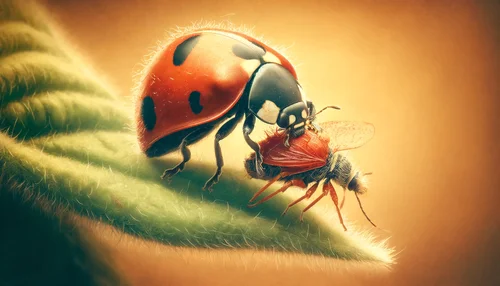That cute, spotted bug that seems to appear out of nowhere? That’s the ladybug. However, ladybugs are valuable creatures in the garden, even though they look cute. These tiny bugs are natural predators that can help your plants stay healthy and grow well. You’ll understand why if you’ve ever had to fight an aphid infestation! These tiny bugs that feed on sap can do a lot of damage to your garden, but ladybugs love them. Let’s talk about why ladybugs are thought to be good for you and how they can help keep your garden healthy.
The Basics
Ladybugs, correctly classified as beetles within the family Coccinellidae of the order Coleoptera, are not true bugs. This classification underscores their unique biological and ecological roles. Globally, the ladybug population boasts approximately 5,000 species, offering a stunning display of biodiversity. In North America alone, garden enthusiasts might encounter around 400 different species, each contributing to the health of plant life in various ways.
Contrary to the typical image of ladybugs as merely red with black spots, these beetles exhibit a spectacular spectrum of colors. Their hues range from yellow and orange to brown and pink; some even don a sleek all-black shell. Additionally, variations in their appearance include individuals with stripes or those completely devoid of markings, adding to the visual richness they bring to their natural habitats. These colorful variations not only make them a delight to observe but also play a crucial role in their survival strategy, signaling their distastefulness to predators.
The Historical Significance of Ladybugs
The affectionate term ‘ladybug’ has roots deep in European history. It is believed that farmers named these insects after the Virgin Mary, who was often depicted wearing a red cloak during medieval times. This name reflects farmers’ deep respect and gratitude for ladybugs, acknowledging their critical role in agriculture.
Why Are Ladybugs Beneficial?
Ladybugs are a gardener’s best friend when it comes to controlling pesky insects that damage plants. They are highly valued for their diet of aphids and other plant-eating pests, which makes them an invaluable asset to any garden. These tiny creatures are capable of eating up to 5,000 insects over their lifetime, making them a natural and effective pest control agent. Their bright and colorful appearance makes them a delightful addition to any garden.
Defense and Hibernation
Ladybugs use their bright colors and distinctive spots as a defense mechanism, indicating to predators that they are unpalatable. They can also emit a foul-smelling liquid from their leg joints to deter predators when threatened. Ladybugs possess hidden wings under their hard, shell-like forewings, allowing them to fly swiftly in response to danger. As the cooler autumn months arrive, ladybugs start to look for warm and sheltered locations to hibernate. During this phase, they frequently gather in colonies of thousands, indicating their social nature.
The Role of Ladybugs in Natural Pest Control
Ladybugs are far more than decorative additions to your garden; they are formidable predators of aphids and other pest insects. Aphids are particularly damaging as they suck the sap from plants, causing wilting, leaf yellowing, and stunted growth. Fortunately, ladybugs excel in controlling these outbreaks. Their strong appetite for aphids positions them as vital contributors to your garden’s natural pest management strategy.
Collaborative Warriors
However, ladybugs are not solitary fighters in the battle against pests. They are integral parts of a complex ecosystem that includes a variety of predatory insects, such as bugs and mites. This biodiversity collaboratively works to maintain pest populations at manageable levels. When ladybugs move from one plant to another, they are often accompanied by other beneficial species like lacewings and parasitic wasps, all playing their part in a self-sustaining garden ecosystem.
Effective Against Stubborn Infestation
Confronting a tough aphid or spider mite problem? Introducing ladybugs might be your best organic strategy. These beetles aren’t just a pretty sight; they actively seek out and eliminate pests from the hidden corners of your garden, areas often missed by other pest control methods. Using ladybugs as a natural pest control solution underscores their utility beyond their aesthetic value—they are efficient garden protectors.
A Sustainable Choice for Garden Health
By leveraging ladybugs’ pest-fighting capabilities, you are choosing a path that promotes the health of your garden and protects the environment. This method allows you to reduce or eliminate the need for chemical pesticides, which can adversely affect non-target species and degrade soil quality. Opting for ladybugs turns your garden into a dynamic ecosystem where these beneficial insects can thrive and effectively manage pest populations, ensuring your plants flourish in a balanced and healthy habitat.

How to Attract and Maintain Ladybugs
If you’re aiming to welcome ladybugs into your garden, think of yourself as a gracious host preparing for esteemed guests. Your goal is to create an environment that not only attracts ladybugs but also convinces them to stay for an extended visit.
The Dietary Draws for Ladybugs
The main lure for ladybugs in any garden is the abundant food supply. These natural predators feast on a variety of pests that threaten plant health. Aphids top the menu; these pests are notorious for draining plant sap and spreading diseases. A single ladybug can consume up to 5,000 aphids, making it an invaluable ally in maintaining plant vitality.
Beyond aphids, ladybugs also target other harmful insects such as scales, mealybugs, and spider mites. During times when these primary food sources are less available, ladybugs adapt by eating pollen and nectar. This versatility not only helps ladybugs sustain themselves but also aids in pollination, enhancing garden health and bloom.
By understanding and supporting the dietary needs of ladybugs, gardeners can encourage these beneficial beetles to thrive in their outdoor spaces, naturally keeping pest populations under control.
Environmental Elements
Yet, food alone isn’t enough. Ladybugs need a place to call home. You can craft shelters by leaving leaf litter and twigs around, or installing insect hotels that provide nooks for these beetles to thrive and reproduce. Remember, ladybugs also need water. Providing shallow water sources, like pebbles in a saucer of water, makes your garden a more inviting space.
Avoiding pesticides goes without saying. Chemical treatments can harm ladybugs and disrupt the natural pest control they provide. Instead, opt for organic solutions such as insecticidal soaps or oils that target pests without collateral damage to beneficial insects.
Releasing Purchased Ladybugs
The success of integrating commercially purchased ladybugs into your garden hinges significantly on the timing of their release. It’s crucial to release them during the twilight hours to maximize the likelihood that these beneficial beetles will acclimate and thrive in their new environment. Ladybugs are less active as the day cools, which reduces their tendency to immediately fly away and increases their chances of settling into their new home.
When releasing ladybugs, position them near plants that are currently suffering from aphid invasions or those that are in full bloom. This strategy provides the ladybugs with immediate food sources—essential for their survival and effectiveness in pest control. Ensuring that these conditions are met will help the ladybugs to begin their work at once, bolstering the health and beauty of your garden by naturally reducing pest populations.
Much like a good host, be observant. Monitor your garden for signs of a healthy ladybug population, like larvae and new generations of beetles. This will help you gauge the success of your efforts and make necessary adjustments to keep your garden an appealing haven for these helpful insects.
Please read my post on The Essential Guide To Garden Beneficial Organisms for a full guide to beneficial organisms.
Challenges and Considerations for Keeping Ladybugs in Your Garden
Despite your best efforts, ladybugs may eventually move on from your garden. This isn’t a sign of failure, but a natural consequence of their behavior. Ladybugs are nomadic by nature and may leave in search of new food sources or mates. It’s important to understand this as part of the cycle of a healthy ecosystem.
If you notice your ladybug guests dwindling, consider whether your garden continues to meet their needs. For instance, a decrease in aphid populations may signal it’s time for the ladybugs to find another food source. Keeping a variety of plants that attract a range of insects can provide a more stable food supply for these beetles.
Remember, a diverse, pesticide-free garden is the backbone of a thriving ladybug community. It’s not just about having them; it’s about creating an environment where they can flourish. Plant native species, foster habitats for a host of beneficial insects, and minimize intervention to let nature do its work.
Assessing the presence of ladybugs can also be a good indicator of your garden’s overall health. Regularly check the biodiversity you’re supporting and adapt your strategies accordingly. Sharing your space with ladybugs is a rewarding experience, but it does require patience and an understanding of their habits.
In the end, the goal is to foster a balanced, eco-friendly space where ladybugs feel welcome but not reliant. Striking this balance is the key to long-term gardening success. Maintain your dedication to a chemical-free approach and embrace the ebb and flow of ladybug populations as part of a dynamic and natural garden life.

